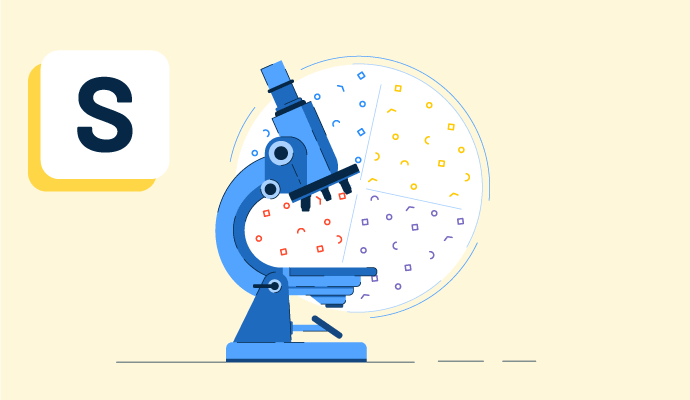What is a SWOT analysis?
SWOT analysis is a framework that organizations employ to figure out their strengths, weaknesses, opportunities, and threats (SWOT) to identify their competitive status and make more effective decisions.
A business explores threats and improves weak areas with a better strategy sculpted with SWOT analysis results. Companies conduct extensive research on their current operations in collaboration with multiple stakeholders. Using project management software maintains transparency among everyone involved in the process.
People play an important role in driving the organization to success. When directors, managers, employees, and other stakeholders understand a company’s position, health, and loopholes, the management can improve its competitive advantage. It prepares a business for internal or external threats while discovering new opportunities.
Components of a SWOT analysis template
Four major components make up a SWOT analysis template.
- Strengths are an organization’s positive attributes. It’s what makes a business stand out from the others. For example, a strong customer base and an advantageous physical location are strengths.
- Weaknesses are the negative factors or resources that make it tricky to succeed. For example, weak branding or huge debt.
- Opportunities uncover new business areas that haven’t been explored yet. These could be training, products, services, or markets. For instance, finding new suppliers means an opportunity to lower the costs of upstream products.
- Threats are situations beyond a company’s control that might interfere with its success. A threat might be something like technological changes or natural disasters.
SWOT analysis matrix
Although the response to each component may vary, the four elements of the SWOT matrix remain constant. This matrix provides a quick overview of an imaginary restaurant’s business situation. The left side of the table focuses on more favorable outcomes, while the right side emphasizes unfavorable ones.
| Strengths: Price, location, and decor | Weaknesses: High debt, inaccessible location |
| Opportunities: Expand across the city | Threats: Poor review |
How to do a SWOT analysis
The steps below outline how to perform a SWOT analysis.
- Objective. A specific objective leads the analysis, however huge the data is. Figuring out whether a product is ready for launch is an example of a concrete objective.
- Research. Thorough research about the business, market, and industry is necessary for SWOT analysis. Knowing the limitations and reliability of data is important.
- Brainstorming. Using relevant data, SWOT analysts need to consider options for each category. They must consider internal and external factors that affect their organizations. At this stage, ideas matter the most; wrong answers don’t exist yet.
- Fine-tuning the findings. Analysts retain logical and realistic ideas after compiling them together. They refine, focus, and prioritize the best ideas and consider those that pose larger risks to a company.
- Strategy. The last step develops strategies to address the issues identified in SWOT.
SWOT analysis benefits
Companies can expect several benefits from performing a SWOT analysis.
- Internal and external factor evaluation. Most of the time, only internal factors are considered when making business decisions. However, external factors can interfere with the success of the organization. A SWOT analysis takes these into account.
- Wide range of applications. SWOT can be applied to competitive analysis, strategic planning, or anything that provides insight into an organization’s favorable and unfavorable circumstances.
- Spotlight on existing resources. SWOT identifies skills and capabilities that may have been ignored.
- Data simplifications. When it comes to decision-making, an overwhelming amount of data must be considered. SWOT analysis helps businesses transform complex data into a comprehensible report.
- Open discussion forums. SWOT analyzes a company's core strengths and weaknesses. This helps stakeholders pitch in growth ideas while ensuring all are on the same page.
SWOT analysis best practices
The best practices to consider are as follows:
- Honesty. Stay honest and have an open conversation to encourage candidness among the team when preparing a SWOT analysis. Avoid wishful thinking.
- Collaboration. Use collaboration software for information exchange between various departments that may not seamlessly collaborate.
- Identify competitors. Ask questions about current competitors and their threats. Find out how they affect your business.
- Be specific. Describe a particular business situation with precision. For example, simply stating 'brand image' won’t help, as it could be both a strength and a weakness.
- Check facts. Verify facts before producing statements. Those statements with no logical explanation that facts can’t back up shouldn’t be considered.
SWOT analysis vs. gap analysis
SWOT analysis helps individuals and organizations find a sense of direction for personal or business planning. Each factor of SWOT makes it easier for organizations to plan their future events. Plus, it’s much easier to visualize since it’s a four-block grid framework.
Gap analysis identifies the difference between the current and potential future state of the business.
SWOT Analysis involves long-term goals, offering a comprehensive study of large complex data. It’s used to process the big picture. A SWOT analysis is not the final step. Instead, it’s just one stage of the decision-making process. Depending upon the goal and business situation, the type of analysis differs. For many complex issues, one has to conduct in-depth research and analysis to continue.
Gap analysis focuses on short-term goals and often reduces its procedure to simple data. Companies turn to gap analysis when more detail-oriented observation is required.
Learn more about how to use SWOT analysis to stay competitive in the market.

Sagar Joshi
Sagar Joshi is a former content marketing specialist at G2 in India. He is an engineer with a keen interest in data analytics and cybersecurity. He writes about topics related to them. You can find him reading books, learning a new language, or playing pool in his free time.



















